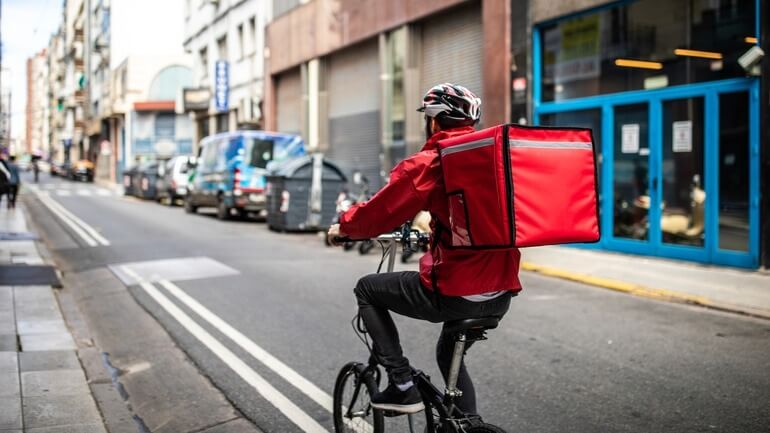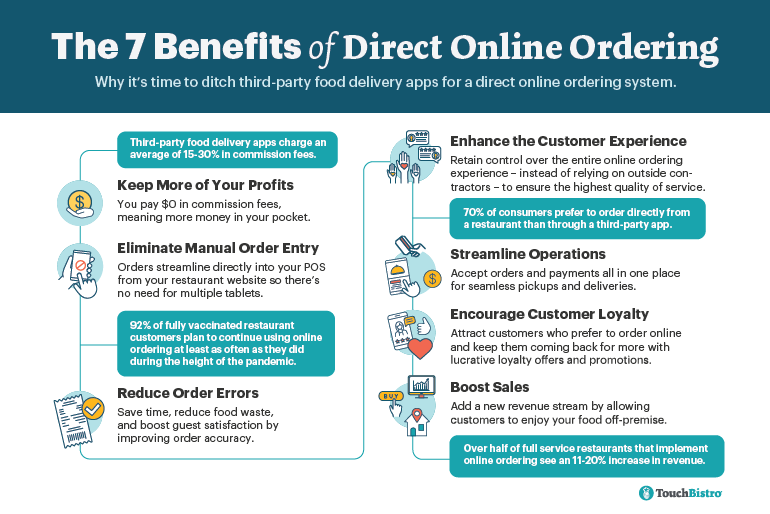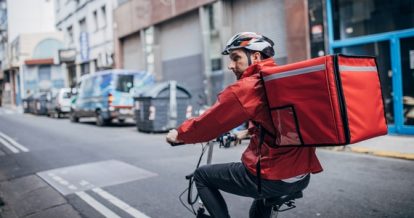In the past few years, the demand for third-party food delivery services has been on a steady rise. But during COVID-19 pandemic, the top four food delivery apps (DoorDash, Uber Eats, Grubhub, and Postmates) more than doubled their business to bring in a combined revenue of roughly $5.5 billion.
And while the pandemic may have been an unprecedented event, the high demand for takeout and delivery appears to be here to stay. As a 2021 study by Buyer’s Edge Platform found, 42.3% of consumers still prefer eating takeout or delivery at home. Additionally, Yelp found that interest in food delivery remains at 189% of 2019 levels, even as people once again return to dining rooms.
It’s clear that food delivery is here to stay, which means restaurants need to figure out how they will incorporate delivery into their businesses (if they haven’t already). In large part, this means deciding whether they want to partner with a third-party restaurant delivery service, or if they want to build their own delivery infrastructure.
To help restaurants navigate this question, this article will cover:
- What is a third-party delivery service?
- The benefits of working with third-party food delivery services
- The drawbacks of using food delivery apps
- Alternatives to the biggest food delivery companies
What Is a Third-Party Delivery Service?
A third-party food delivery service is a company that partners with restaurants to create an online marketplace where customers can browse restaurant menus and place orders to be delivered to their homes. In most cases, the deliveries are carried out by independent contractors, who have been hired by the company to deliver food from restaurants directly to customers.
In North America, the biggest third-party food delivery services include Uber Eats, DoorDash, Gubhub, and Postmates. In the U.K. and Europe, Deliveroo and Just Eat are also among the biggest food delivery companies.
Benefits of Third-Party Food Delivery
The rise of these third-party delivery services is not surprising given the many benefits these companies offer, including:
Low Barrier to Entry
For restaurants, one of the biggest benefits of signing up for a third-party food delivery app is the low barrier to entry. Most of these companies allow restaurants to sign up online in just a few easy steps and pay a one-time fee for all the necessary hardware and software.
This means that restaurants can start accepting orders for deliveries extremely quickly – a major plus for new restaurants or venues that need to quickly pivot from on-premise dining to an off-premise restaurant model.
Popularity
Another big benefit of partnering with a third-party restaurant delivery service is that you gain access to a built-in diner network. In the U.S. alone, a 2020 report shows that 111 million people were using food delivery apps. Not to mention, a study by Zion & Zion found that almost two-thirds (63%) of adults aged 18 to 29 years have used a third-party food delivery company.
This means that when restaurants sign up with these third-party companies, they get added to a marketplace where they can be discovered by a whole new audience of diners. And all that exposure can translate into more business for the restaurant.
Convenience
Last but not least is the convenience factor. When restaurants sign up with a food delivery app like Uber Eats or DoorDash, they gain access to a built-in network of independent delivery drivers who will carry out all of the restaurant’s deliveries.
This network of delivery drivers is a major plus for restaurants because it means that restaurants don’t have to spend time, energy, and money hiring in-house food delivery drivers.

Drawbacks to Food Delivery Apps
While third-party food delivery services certainly offer some big benefits for restaurants, they also come with quite a few drawbacks. While pricey commission fees have always been a concern for restaurants, the increasing reliance on food delivery apps during the pandemic also brought to light many other concerns for restaurateurs.
1. High Fees
As mentioned, the high fees associated with third-party delivery apps have long been an issue for many restaurateurs. Most apps charge a per-transaction fee, which is generally a percentage of each order or of net online sales made through the app. The fees differ depending on the location of your restaurant, with busier areas typically having higher fees. However, on average, restaurants can expect to pay 15-30% per order in fees.
The problem is, the average profit margin for most restaurants already falls below 30%. For fast casual, casual, and full-service restaurants, the average profit margin is around 6%. This means that for many restaurants, paying 30% in commission means they’re actually losing money on each delivery order – profits that they need to make up in some other way.
And it’s not just restaurants facing high fees. Customers are also paying a premium when they use food delivery apps like Uber Eats. In fact, one New York Times reporter found that the markups on food deliveries can be up 91% more than what you would pay if you bought the meal directly from the restaurant.
2. Less Control Over the Customer Experience
Even for restaurants that are able to make the math work, using third-party food delivery services can also mean losing a bit of control over the end-to-end customer experience. That’s because once the food leaves a restaurant, it’s handed over to an independent contractor who works for the third-party food delivery company. This means restaurants have less control over whether the order will arrive in a timely manner.
While many restaurants rely on third-party drivers with little to no issues, it’s worth noting that restaurants are required to give up some level of control by using third-party delivery fleets – something that not every restaurateur may be comfortable with.
3. Order Errors
Beyond lengthy delivery times, restaurants also face a higher risk of order errors when using third-party food delivery apps due to the way information flows into the restaurant’s POS system.
Generally, when restaurants sign up for a third-party service, they’ll be given a tablet loaded with the company’s software, which they can use to manage all the orders that come in through that specific food delivery app. The problem is that this information doesn’t flow directly into the restaurant’s POS system, which means staff must manually input order information from any delivery app tablets into the restaurant’s POS system – a situation that raises the risk of order entry errors.
In turn, these kinds of order errors can lead to a poor customer experience and negative reviews. And with 94% consumers reporting that negative reviews have convinced them to avoid a business, bad reviews can put a major dent in a restaurant’s future sales.
4. Difficult to Promote Customer Loyalty
Maintaining a great reputation and a loyal customer base is essential for restaurants, and using third-party food delivery services can make this tricky because the restaurant is now one step removed from the customer. In other words, when customers make all their orders through a food delivery app, their loyalty may shift away from the restaurant to the third-party app.
For restaurants that use delivery apps, it can be a challenge to enroll customers in their in-house restaurant loyalty program because food delivery apps encourage customers to join the app’s rewards program instead. For instance, DoorDash has a subscription program called DashPass that lets subscribers enjoy $0 delivery fees and reduced service fees on all DashPass orders over $12. While this is a tempting offer for anyone who regularly orders food for delivery, it’s a costly program for merchants. As DoorDash explains on its website, restaurants can expect to pay a commission rate of 28% on all orders placed by DashPass customers.
Ultimately, the problem with these kinds of in-app loyalty programs is not just that they’re costly for restaurants to use, but they are also designed to keep the user experience entirely within the app. This makes it more difficult for restaurants to make use of in-house loyalty programs that give them more control over the kind of rewards they offer and their communication with customers.
In-House Online Ordering
An in-house solution like TouchBistro Online Ordering, enables customers to place orders directly on your restaurant’s website and provides the option to offer delivery through an integration with DoorDash Drive. With this commission-free delivery solution, you gain access to an on-demand network of local drivers who help to get your orders from door to door without lifting a finger.
These orders can be placed to be prepared right away or scheduled for later, and the information is all streamlined directly into your POS in real-time. You can also set fees to help you strike a balance between happy customers and healthy margins by choosing to pass some or all of your delivery fees on to diners.
And with the TouchBistro Online Ordering and TouchBistro Loyalty integration, customers can earn and redeem rewards every time they order online.
For restaurants, this kind of online ordering system helps to combat many of the challenges associated with using third-party food delivery apps. Not only does direct online ordering help restaurants keep more profits from each order, but it also helps to reduce order errors, give restaurants more control over the customer experience, and ultimately improve customer retention.

And it’s not just restaurants that reap the benefits of direct online ordering. When customers order directly from a restaurant, they’re able to save on the many fees that third-party food delivery apps attach to each order. Ordering direct also allows customers to directly support their favorite venues, which is something that has become particularly important to many consumers in the wake of the pandemic. In fact, a Sense360 study found that 63% of consumers prefer to order delivery directly from the restaurant, versus just 18% who prefer to use third parties.
At the end of the day, third-party food delivery services can provide a valuable service for venues that need a quick and easy restaurant delivery service solution. However, this convenience comes at a major cost, which means restaurants must carefully consider partnering with delivery apps before signing on the dotted line.
Free online ordering signs for your restaurant
Sign up for our free weekly TouchBistro Newsletter







